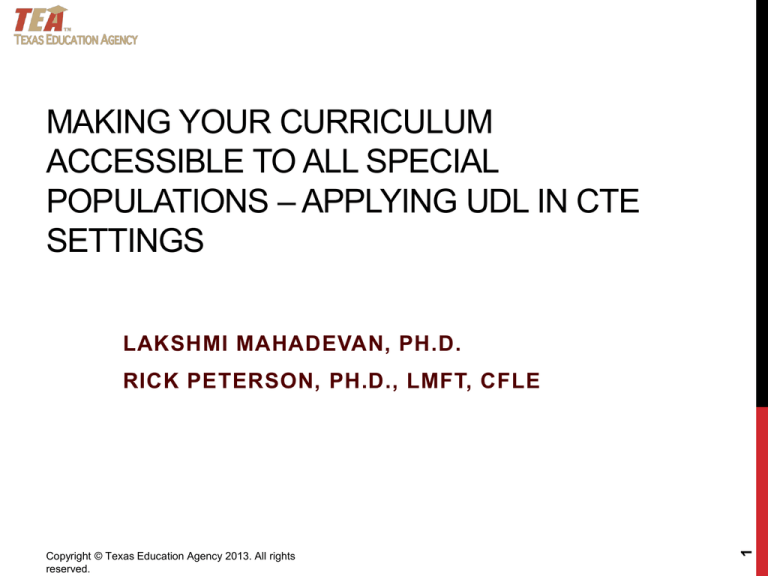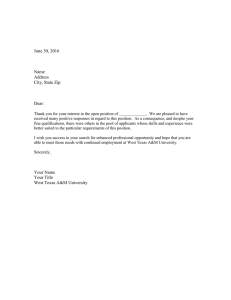
MAKING YOUR CURRICULUM
ACCESSIBLE TO ALL SPECIAL
POPULATIONS – APPLYING UDL IN CTE
SETTINGS
LAKSHMI MAHADEVAN, PH.D.
Copyright © Texas Education Agency 2013. All rights
reserved.
1
RICK PETERSON, PH.D., LMFT, CFLE
Copyright © Notice The materials are copyrighted © and trademarked ™ as the property of the Texas Education
Agency (TEA) and may not be reproduced without the express written permission of TEA, except under the
following conditions:
1.
2.
3.
4.
Texas public school districts, charter schools, and Education Service Centers may reproduce and use copies of
the Materials and Related Materials for the districts’ and schools’ educational use without obtaining permission
from TEA.
Residents of the state of Texas may reproduce and use copies of the Materials and Related Materials for
individual personal use only without obtaining written permission of TEA.
Any portion reproduced must be reproduced in its entirety and remain unedited, unaltered and unchanged in
any way.
No monetary charge can be made for the reproduced materials or any document containing them; however, a
reasonable charge to cover only the cost of reproduction and distribution may be charged.
Private entities or persons located in Texas that are not Texas public school districts, Texas Education Service
Centers, or Texas charter schools or any entity, whether public or private, educational or non-educational, located
outside the state of Texas MUST obtain written approval from TEA and will be required to enter into a license
agreement that may involve the payment of a licensing fee or a royalty.
Copyright © Texas Education Agency 2013. All rights reserved.
2
For information contact: Office of Copyrights, Trademarks, License Agreements, and Royalties, Texas Education
Agency, 1701 N. Congress Ave., Austin, TX 78701-1494; phone 512-463-9270 or 512-463-9713; email:
copyrights@tea.state.tx.us.
OBJECTIVES
Definition of Universal Design for Learning
(UDL)
Principles of UDL
Examples – Principle I
Examples – Principle II
Examples – Principle III
Copyright © Texas Education Agency 2013. All rights reserved.
3
CTE UDL Master List
DEFINITION
Definition: Universal Design for Learning is
an educational approach for designing
curriculum for all learners. UDL is based on
three principles:
Copyright © Texas Education Agency 2013. All rights reserved.
4
Source: Adapted from:
http://www.cast.org/about/index.html
PRINCIPLES
Multiple means of representation, to give diverse
learners options for acquiring information and
knowledge
Multiple means of action and expression, to give
diverse learners options for demonstrating and
acting upon information and knowledge
Copyright © Texas Education Agency 2013. All rights reserved.
5
Multiple means of engagement, to tap into
learners' interests, offer appropriate challenges,
and increase motivation
REPRESENTATION
Copyright © Texas Education Agency 2013. All rights reserved.
6
Remove barriers to students’ learning
by providing the same information
through different modalities.
STRATEGIES FOR REPRESENTATION
Provide Options for Perception
Copyright © Texas Education Agency 2013. All rights reserved.
7
• Change the contrast between background and text or
image
• Change the color you use for information or emphasis
• Change the layout of visual or other elements
• Use text equivalents such as captions or speech-to-text
software (e.g. voice recognition) for spoken language
• Use physical objects and models to teach abstract
concepts.
STRATEGIES CONT’D
Provide options for language, mathematical
expressions, and symbols.
Copyright © Texas Education Agency 2013. All rights reserved.
8
• Present key concepts in different forms for e.g.
text and illustration, photograph, video etc.
• Clarify complex syntax by offering simpler
sentence alternatives
• Pre-teach vocabulary and symbols such that
they connect to students' life experiences and
prior knowledge.
STRATEGIES CONT’D
Provide options for comprehension
Copyright © Texas Education Agency 2013. All rights reserved.
9
• Bridge key concepts with analogies and metaphors.
• Use outlines, graphic organizers, unit organizer routines,
concept organizer routines, and concept mastery
routines to emphasize key ideas and relationships.
• Use cues and prompts to draw attention to critical
features.
• Encourage the use of mnemonic strategies and devices
(e.g., visual imagery, paraphrasing strategies, method of
loci, etc.)
VIDEO STRATEGIES
Representation – In general
Book on tape
Graphic organizer
Video simulations
Decoding
Copyright © Texas Education Agency 2013. All rights reserved.
10
Using Simple Language
CAUSE AND EFFECT
Causes:
Copyright © Texas Education Agency 2013. All rights reserved.
11
Effect(s):
Copyright © Texas Education Agency 2013. All rights reserved.
12
VENN DIAGRAM
SPIDER MAP
Fact
Feature
Suppor
-ting
Idea
Attribute
Topic/
Exam
-ple
Copyright © Texas Education Agency 2013. All rights reserved.
Concept
Quotes
Data
13
Theory
ASSISTIVE TECHNOLOGY (AT)
Copyright © Texas Education Agency 2013. All rights reserved.
14
Magnifying
– Screen
and
Handheld
WYNN software that
highlights in context as
text is spoken aloud.
Includes the ability to
modify electronic files,
scan pages, or create new
documents
Copyright © Texas Education Agency 2013. All rights reserved.
15
AT CONT’D
AT VIDEOS
Copyright © Texas Education Agency 2013. All rights reserved.
16
Closed Circuit TV
ACTION AND EXPRESSION
Copyright © Texas Education Agency 2013. All rights reserved.
17
Provide multiple and flexible means of
expression to provide diverse students
with alternatives for demonstrating what
they have learned.
STRATEGIES FOR ACTION AND
EXPRESSION
Provide options for physical action.
Copyright © Texas Education Agency 2013. All rights reserved.
18
• Provide opportunities for working with
materials using hands.
• Vary requirements for physically responding
to or indicating selections among response
types (e.g., marking with pen and pencil
instead of using a mouse).
• Provide opportunities for working with
materials using a joystick or an adapted
mouse.
STRATEGIES CONT’D
Copyright © Texas Education Agency 2013. All rights reserved.
19
Provide options for expressive skills and fluency
• Allow students to provide products using
multiple media.
• Provide opportunities for students to create
models that demonstrate the same outcomes
but use differing approaches, strategies, skills,
etc.
• Offer differentiated feedback (e.g., feedback that
is accessible because it can be customized to
individual learners).
STRATEGIES CONT’D
Provide options for executive functions
Copyright © Texas Education Agency 2013. All rights reserved.
20
• Model for students or demonstrate examples
of the process and product of goal-setting.
• Offer guides and checklists for scaffolding
students’ goal-setting.
• Provide representations of progress (e.g.,
before and after photos, graphs and charts
showing progress over time).
VIDEO EXAMPLES
Action and Expression – In general
Using Realia
Demonstrating
Test Reviews
Oral Explanation
Build Models
Copyright © Texas Education Agency 2013. All rights reserved.
21
Encourage Participation
AT
Copyright © Texas Education Agency 2013. All rights reserved.
22
Two way
communication
radios using FM
technology.
Also fits directly
into individuals’
hearing aid.
AT CONT’D
Copyright © Texas Education Agency 2013. All rights reserved.
23
Adapted
mouse
types
AT CONT’D
Dragon Naturally
Speaking
Copyright © Texas Education Agency 2013. All rights reserved.
24
Using voice to
create email,
documents and
spreadsheets.
Helps control
PC/MAC by talking
to it, starting
programs, using
menus and surfing
the Internet.
AT VIDEO
Copyright © Texas Education Agency 2013. All rights reserved.
25
Head Tracker
ENGAGEMENT
Copyright © Texas Education Agency 2013. All rights reserved.
26
Provide multiple and flexible means of
engagement to tap into diverse learners'
interests, challenge them appropriately, and
motivate them to learn.
STRATEGIES FOR ENGAGEMENT
Provide options for recruiting interest
Copyright © Texas Education Agency 2013. All rights reserved.
27
• Design activities so that outcomes are
authentic, communicate to real audiences,
and are purposeful.
• Invite students to provide personal
responses, evaluation, and self-reflection to
content and activities.
• Give students as much discretion and
autonomy as possible by providing choices
STRATEGIES CONT’D
Provide options for sustaining effort and
persistence.
Copyright © Texas Education Agency 2013. All rights reserved.
28
• Ensure the division of long-term goals into shortterm objectives.
• Offer prompts that guide students in when and how
to ask peers and/or teachers for help.
• Provide feedback that encourages perseverance,
focuses on development of efficacy and selfawareness, and encourages the use of specific
supports and strategies in the face of challenges.
STRATEGIES CONT’D
Provide options for self-regulation
Copyright © Texas Education Agency 2013. All rights reserved.
29
• Differentiate models, scaffolds, and feedback
such that students can manage frustration.
• Arrange for coaches, mentors, or agents that
model the process of setting personally
appropriate goals.
• Increase the length of on-task task
orientation in the face of distractions
• Elevate the frequency of self-reflection and
self-reinforcement
Copyright © Texas Education Agency 2013. All rights reserved.
30
ACCESS TO TECHNOLOGY
Copyright © Texas Education Agency 2013. All rights reserved.
31
LEVELED QUESTIONS
Copyright © Texas Education Agency 2013. All rights reserved.
32
RELATE PERSONALLY TO MATERIAL
VIDEO EXAMPLES
Engagement in general
Use humor
Partnering
Provide rationale
State objectives
Copyright © Texas Education Agency 2013. All rights reserved.
33
Close class
BENEFITS OF UDL
Building accessibility into design helps to
ensure that features meeting the needs of the
widest range of students are incorporated
integrally into the curricula. Such designs can
prevent the need for adaptations or retrofitting.
Copyright © Texas Education Agency 2013. All rights reserved.
34
Providing adaptable materials and media allows
students to choose and customize formats
suited to their learning needs.
BENEFITS CONT’D
Using multiple media, such as video and audio
formats, provides a variety of ways to represent
a concept and allows students to access the
materials through different senses.
Presenting information in multiple, parallel forms
help to accommodate diverse learning styles.
Copyright © Texas Education Agency 2013. All rights reserved.
35
Providing challenging, salient, and ageappropriate materials to all students motivates
students who may not otherwise be able to
access curricular content they need given their
age and developmental level.
Copyright © Texas Education Agency 2013. All rights reserved.
36
Questions ?
WEBSITE AND
CONTACT INFORMATION
For more information please go to:
http://ctsp.tamu.edu
Copyright © Texas Education Agency 2013. All rights reserved.
37
Mailing Address:
Texas A&M AgriLife Extension Service
Attn: Lakshmi Mahadevan
TAMU MS 2251
College Station, TX 77843-2251
Phone: 979-845-2444/979-845-4374
Fax: 979-845-6496
Email: ctsp@tamu.edu

